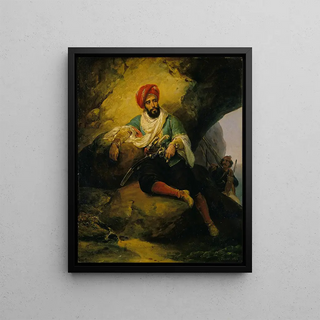Art print | Conrad the Corsair - Horace Vernet


View from behind

Frame (optional)
In the fascinating world of art, some works stand out for their ability to capture the collective imagination. "Conrad the Privateer" by Horace Vernet is a perfect example. This painting, which evokes the bravery and daring of privateers, immerses the viewer in a world where maritime adventure and the quest for freedom intertwine. Vernet, master of dynamic representation and movement, succeeds in conveying a dramatic intensity that makes this artwork a true masterpiece. The scene, rich in detail and emotion, invites contemplation and escapism, making the art print of Conrad the Privateer - Horace Vernet particularly appealing for those wishing to enrich their living space with a touch of history and passion.
Style and uniqueness of the work
Horace Vernet's style is characterized by striking realism and meticulous attention to detail. In "Conrad the Privateer," the artist deploys a vibrant color palette that emphasizes the movement of the waves and the energy of the characters. The faces, expressive and full of life, each tell a story, while the tumultuous sea, painted with undeniable mastery, seems to pulse beneath the brushstrokes. The composition, skillfully orchestrated, guides the viewer's gaze across the scene, creating a dynamic that evokes the thrill of adventure. Every element, from the ship to the characters, is carefully arranged to reinforce the impression of movement and urgency. Thus, this work is not just a static representation; it becomes an open window to an epic story, inviting everyone to dive into it.
The artist and his influence
Horace Vernet, born in 1789, is one of the most emblematic artists of 19th-century France. His career is marked by an unwavering passion for depicting military and maritime scenes. Influenced by the great traditions of classical art, he manages to infuse a modern touch into his works, blending realism and romanticism. Vernet also distinguished himself through his travels, which allowed him to explore diverse cultures and enrich his visual repertoire. His influence extends to

Matte finish

View from behind

Frame (optional)
In the fascinating world of art, some works stand out for their ability to capture the collective imagination. "Conrad the Privateer" by Horace Vernet is a perfect example. This painting, which evokes the bravery and daring of privateers, immerses the viewer in a world where maritime adventure and the quest for freedom intertwine. Vernet, master of dynamic representation and movement, succeeds in conveying a dramatic intensity that makes this artwork a true masterpiece. The scene, rich in detail and emotion, invites contemplation and escapism, making the art print of Conrad the Privateer - Horace Vernet particularly appealing for those wishing to enrich their living space with a touch of history and passion.
Style and uniqueness of the work
Horace Vernet's style is characterized by striking realism and meticulous attention to detail. In "Conrad the Privateer," the artist deploys a vibrant color palette that emphasizes the movement of the waves and the energy of the characters. The faces, expressive and full of life, each tell a story, while the tumultuous sea, painted with undeniable mastery, seems to pulse beneath the brushstrokes. The composition, skillfully orchestrated, guides the viewer's gaze across the scene, creating a dynamic that evokes the thrill of adventure. Every element, from the ship to the characters, is carefully arranged to reinforce the impression of movement and urgency. Thus, this work is not just a static representation; it becomes an open window to an epic story, inviting everyone to dive into it.
The artist and his influence
Horace Vernet, born in 1789, is one of the most emblematic artists of 19th-century France. His career is marked by an unwavering passion for depicting military and maritime scenes. Influenced by the great traditions of classical art, he manages to infuse a modern touch into his works, blending realism and romanticism. Vernet also distinguished himself through his travels, which allowed him to explore diverse cultures and enrich his visual repertoire. His influence extends to






